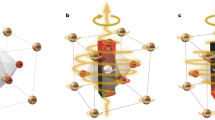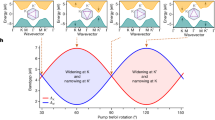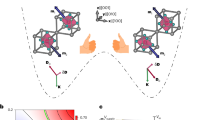Abstract
Birefringence is a fundamental optical property that can induce phase retardation of polarized light. Tuning the birefringence of liquid crystals is a core technology for light manipulation in current applications in the visible and infrared spectral regions. Due to the strong absorption or instability of conventional liquid crystals in deep-ultraviolet light, tunable birefringence remains elusive in this region, notwithstanding its significance in diverse applications. Here we show a stable and birefringence-tunable deep-ultraviolet modulator based on two-dimensional hexagonal boron nitride. It has an extremely large optical anisotropy factor of 6.5 × 10−12 C2 J−1 m−1 that gives rise to a specific magneto-optical Cotton–Mouton coefficient of 8.0 × 106 T−2 m−1, which is about five orders of magnitude higher than other potential deep-ultraviolet-transparent media. The large coefficient, high stability (retention rate of 99.7% after 270 cycles) and wide bandgap of boron nitride collectively enable the fabrication of stable deep-ultraviolet modulators with magnetically tunable birefringence.
This is a preview of subscription content, access via your institution
Access options
Access Nature and 54 other Nature Portfolio journals
Get Nature+, our best-value online-access subscription
$29.99 / 30 days
cancel any time
Subscribe to this journal
Receive 12 print issues and online access
$259.00 per year
only $21.58 per issue
Buy this article
- Purchase on Springer Link
- Instant access to full article PDF
Prices may be subject to local taxes which are calculated during checkout



Similar content being viewed by others
Data availability
The data that support the findings of this study are available within the paper and the Supplementary Information. Other relevant data are available from the corresponding authors on reasonable request. Source data are provided with this paper.
References
Mitchison, J. M. Birefringence of Amœbæ. Nature 166, 313–314 (1950).
Beaufort, L., Barbarin, N. & Gally, Y. Optical measurements to determine the thickness of calcite crystals and the mass of thin carbonate particles such as coccoliths. Nat. Protoc. 9, 633–642 (2014).
Savage, N. Digital spatial light modulators. Nat. Photonics 3, 170–172 (2009).
Park, J., Lee, K. & Park, Y. Ultrathin wide-angle large-area digital 3D holographic display using a non-periodic photon sieve. Nat. Commun. 10, 1304 (2019).
Padgett, M. & Bowman, R. Tweezers with a twist. Nat. Photonics 5, 343–348 (2011).
Muheim, R., Phillips, J. B. & Åkesson, S. Polarized light cues underlie compass calibration in migratory songbirds. Science 313, 837–839 (2006).
Demus, D. 100 years liquid crystal chemistry. Mol. Cryst. Liq. Cryst. Incorporating Nonlinear Opt. 165, 45–84 (1988).
Wei, W.-S., Xia, Y., Ettinger, S., Yang, S. & Yodh, A. G. Molecular heterogeneity drives reconfigurable nematic liquid crystal drops. Nature 576, 433–436 (2019).
Song, W., Kinloch, I. A. & Windle, A. H. Nematic liquid crystallinity of multiwall carbon nanotubes. Science 302, 1363–1363 (2003).
Shen, T.-Z., Hong, S.-H. & Song, J.-K. Electro-optical switching of graphene oxide liquid crystals with an extremely large Kerr coefficient. Nat. Mater. 13, 394–399 (2014).
Woltman, S. J., Jay, G. D. & Crawford, G. P. Liquid-crystal materials find a new order in biomedical applications. Nat. Mater. 6, 929–938 (2007).
Kneissl, M., Seong, T.-Y., Han, J. & Amano, H. The emergence and prospects of deep-ultraviolet light-emitting diode technologies. Nat. Photonics 13, 233–244 (2019).
Kubota, Y., Watanabe, K., Tsuda, O. & Taniguchi, T. Deep ultraviolet light-emitting hexagonal boron nitride synthesized at atmospheric pressure. Science 317, 932–934 (2007).
Taniyasu, Y., Kasu, M. & Makimoto, T. An aluminium nitride light-emitting diode with a wavelength of 210 nanometres. Nature 441, 325–328 (2006).
Tudi, A., Han, S., Yang, Z. & Pan, S. Potential optical functional crystals with large birefringence: recent advances and future prospects. Coord. Chem. Rev. 459, 214380 (2022).
Xu, Z. & Sadler, B. M. Ultraviolet communications: potential and state-of-the-art. IEEE Commun. Mag. 46, 67–73 (2008).
Khan, A., Balakrishnan, K. & Katona, T. Ultraviolet light-emitting diodes based on group three nitrides. Nat. Photonics 2, 77–84 (2008).
Wen, C.-H., Gauza, S. & Wu, S.-T. Ultraviolet stability of liquid crystals containing cyano and isothiocyanato terminal groups. Liq. Cryst. 31, 1479–1485 (2004).
Lan, T., Ding, B. & Liu, B. Magneto-optic effect of two-dimensional materials and related applications. Nano Sel. 1, 298–310 (2020).
Ding, B. et al. Giant magneto-birefringence effect and tuneable colouration of 2D crystal suspensions. Nat. Commun. 11, 3725 (2020).
Ding, B. et al. Largely tunable magneto-coloration of monolayer 2D materials via size tailoring. ACS Nano 15, 9445–9452 (2021).
Lan, T. et al. Collective behavior induced highly sensitive magneto-optic effect in 2D inorganic liquid crystals. J. Am. Chem. Soc. 143, 12886–12893 (2021).
Dai, S. et al. Tunable phonon polaritons in atomically thin van der Waals crystals of boron nitride. Science 343, 1125–1129 (2014).
Caldwell, J. D. et al. Photonics with hexagonal boron nitride. Nat. Rev. Mater. 4, 552–567 (2019).
Giles, A. J. et al. Ultralow-loss polaritons in isotopically pure boron nitride. Nat. Mater. 17, 134–139 (2018).
Segura, A. et al. Natural optical anisotropy of h-BN: highest giant birefringence in a bulk crystal through the mid-infrared to ultraviolet range. Phys. Rev. Mater. 2, 024001 (2018).
Cassabois, G., Valvin, P. & Gil, B. Hexagonal boron nitride is an indirect bandgap semiconductor. Nat. Photonics 10, 262–266 (2016).
Watanabe, K., Taniguchi, T. & Kanda, H. Direct-bandgap properties and evidence for ultraviolet lasing of hexagonal boron nitride single crystal. Nat. Mater. 3, 404–409 (2004).
Wang, M., He, L., Zorba, S. & Yin, Y. Magnetically actuated liquid crystals. Nano Lett. 14, 3966–3971 (2014).
Eremin, A. et al. Peculiarities of the magneto-optical response in dispersions of anisometric pigment nano-particles. RSC Adv. 6, 80666–80669 (2016).
Peterlin, A. & Stuart, H. A. Über den Einfluß der Rotationsbehinderung und der Anisotropie des inneren Feldes auf die Polarisation von Flüssigkeiten. Z. Angew. Phys. 113, 663–696 (1939).
Taylor, E. W. & Cramer, W. Birefringence of protein solutions and biological systems. I. Biophys. J. 3, 127–141 (1963).
O’Konski, C. T., Yoshioka, K. & Orttung, W. H. Electric properties of macromolecules. IV. Determination of electric and optical parameters from saturation of electric birefringence in solutions. J. Phys. Chem. 63, 1558–1565 (1959).
Jennings, B. R., Wilson, S. R. & Ridler, P. J. Magnetic birefringence of minerals. J. Colloid Interface Sci. 281, 368–376 (2005).
Rah, Y., Jin, Y., Kim, S. & Yu, K. Optical analysis of the refractive index and birefringence of hexagonal boron nitride from the visible to near-infrared. Opt. Lett. 44, 3797–3800 (2019).
Pakdel, A., Bando, Y. & Golberg, D. Nano boron nitride flatland. Chem. Soc. Rev. 43, 934–959 (2014).
Hong, J., Jin, C., Yuan, J. & Zhang, Z. Atomic defects in two-dimensional materials: from single-atom spectroscopy to functionalities in opto-/electronics, nanomagnetism, and catalysis. Adv. Mater. 29, 1606434 (2017).
Li, J.-M. Robust 2D room-temperature dilute ferrimagnetism enhancement in freestanding ammoniated atom-thin [0001] h-BN nanoplates. ACS Appl. Mater. Interfaces 9, 39626–39634 (2017).
Si, H. et al. Large-scale synthesis of few-layer F-BN nanocages with zigzag-edge triangular antidot defects and investigation of the advanced ferromagnetism. Nano Lett. 15, 8122–8128 (2015).
Acknowledgements
We acknowledge support by the National Natural Science Foundation of China (No. 51920105002, 52125309, 52188101, 51991343 and 51991340), the Guangdong Innovative and Entrepreneurial Research Team Program (No. 2017ZT07C341), the Shenzhen Basic Research Project (No. WDZC20200819095319002 and JCYJ20190809180605522), the National Key R&D Program (2018YFA0307300) and the Bureau of Industry and Information Technology of Shenzhen for the ‘2017 Graphene Manufacturing Innovation Centre Project’ (No. 201901171523). We thank L. Qiu, J. Liu, Y. Hao, J. Tan, M. Liu, S. Lan, F. Cai, L. Dai, Z. Xie and N. Lei for discussions, sample fabrication and part of material characterization.
Author information
Authors and Affiliations
Contributions
B.D., H-M.C. and B.L. designed and conceived the project. S.C., Y.X. and Y.P. prepared 2D h-BN materials. H.X., Y.X. and B.D. fabricated the devices and performed magneto-optical measurements. H.X., Z.H., B.D. and B.L. performed the material characterization. D.W., Y.X. and B.D. performed the magnetism characterization. Z.H., Y.X., T.L. and B.D. performed the theoretical calculations. B.D., H.X., Z.H., S.C., H-M.C. and B.L. analysed the data and wrote the paper with the input from all authors.
Corresponding authors
Ethics declarations
Competing interests
The authors declare no competing interests.
Peer review
Peer review information
Nature Nanotechnology thanks Guillaume Cassabois and the other, anonymous, reviewer(s) for their contribution to the peer review of this work.
Additional information
Publisher’s note Springer Nature remains neutral with regard to jurisdictional claims in published maps and institutional affiliations.
Supplementary information
Supplementary Information
Supplementary Notes 1–3, Tables 1–3 and Supplementary Figs. 1–16.
Supplementary Video 1
Magneto-optical switching of 2D h-BN LCs.
Supplementary Video 2
Alignment of 2D h-BN membrane in a magnetic field.
Supplementary Video 3
Magneto-optical DUV light modulation of 2D h-BN LCs.
Source data
Source Data Fig. 1
Source data for Fig. 1a–c.
Source Data Fig. 2
Source data for Fig. 2a,b,d,e.
Source Data Fig. 3
Source data for Fig. 3a,c–f.
Rights and permissions
Springer Nature or its licensor holds exclusive rights to this article under a publishing agreement with the author(s) or other rightsholder(s); author self-archiving of the accepted manuscript version of this article is solely governed by the terms of such publishing agreement and applicable law.
About this article
Cite this article
Xu, H., Ding, B., Xu, Y. et al. Magnetically tunable and stable deep-ultraviolet birefringent optics using two-dimensional hexagonal boron nitride. Nat. Nanotechnol. 17, 1091–1096 (2022). https://doi.org/10.1038/s41565-022-01186-1
Received:
Accepted:
Published:
Issue Date:
DOI: https://doi.org/10.1038/s41565-022-01186-1
This article is cited by
-
A new route towards polarized luminescence: 0D/2D nanocomposites
Light: Science & Applications (2024)
-
A multifunctional optoelectronic device based on 2D material with wide bandgap
Light: Science & Applications (2023)
-
Deep ultraviolet hydrogel based on 2D cobalt-doped titanate
Light: Science & Applications (2023)
-
p-Type Two-Dimensional Semiconductors: From Materials Preparation to Electronic Applications
Nano-Micro Letters (2023)
-
On the CO\(_{2}\) adsorption in a boron nitride analog for the recently synthesized biphenylene network: a DFT study
Journal of Molecular Modeling (2023)



